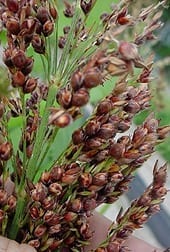Sweet sorghum is primarily grown in the United States as a source of sugar for syrup and molasses.
But the sturdy grass has other attributes that could make it uniquely suited to production as a bioenergy crop, U.S. Department of Agriculture (USDA) studies suggest.
Sorghum is an ideal candidate because of its drought tolerance, adaptability to diverse growing conditions, low nitrogen fertilizer requirements, and high biomass (plant material) content, according to molecular biologist Scott Sattler and collaborator Jeff Pedersen with USDA’s Agricultural Research Service (ARS). It also produces soluble sugar that can be converted to biofuel. Residual fibers left over from the juice extraction process also can be burned to generate electricity.
Sattler and Pedersen’s studies of sorghum are part of a larger effort by ARS-USDA’s principal intramural scientific research agency-to answer a government mandate calling for the production of up to 36 billion gallons of biofuel by 2022. Approximately 15 billion gallons of that total will come from grain ethanol, with the remaining 21 billion gallons to come from other sources, or “feedstocks,” including sorghum, sugarcane, other grasses like switchgrass, and oilseed crops like rapeseed and soybean.
Sorghum and sugarcane are top candidates for production in the southeastern United States because they are complementary crops that can extend the biofuel production season and utilize the same equipment, note Sattler and Pedersen, who work at the ARS Grain, Forage and Bioenergy Research Unit in Lincoln, Neb.
via USDA – Jan Suszkiw
The Latest Streaming News: Bioenergy Crop updated minute-by-minute
Bookmark this page and come back often
Latest NEWS
Latest VIDEO









